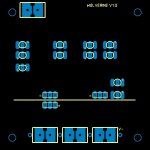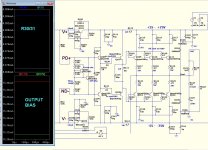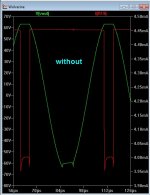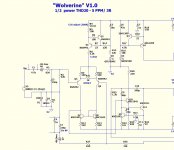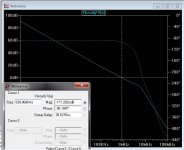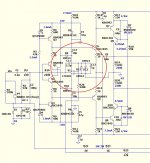OS, it would be nice if you can come up with the same size board IPS but VFA this time,
so that perhaps a relay type change over to either topology is possible, crazy idea...😀
so that perhaps a relay type change over to either topology is possible, crazy idea...😀
You read my mind , AJT !
All OPS and IPS are perfect 76.2mm (3 inch for N. america) width.
All connectors are ANY combo of 2/3/4/ or even a 10 position
5mm LS standard euro- terminal.
Board holes are 6.27mm from corners (1/4").
All VAS TO-126 devices are 25mm apart ,
and use the same 25 X 60mm aluminum flashing or copper plate like the badger.
Electrically - ALL IPS's have 4-6ma VAS's , draw 12-16ma per rail from the multipliers (on OPS PCB) ,
and can run 55-85V rail voltage (standard or boosted).
The reason for 76mm width is that cheap Ebay surplus FR-4 comes in 3/6/12"
lengths.
Below is the "wolverine" standard IPS.
I'm also working on the 5 pair OP - it is just an "extension" of the 3 pair OPS.
I'll release all of them simultaneously. (2 OPS /2 IPS )
PS- My CFA (NAD-NX) and the Wolverine have EXACTLY 4.6mA VAS current , swap to the OPS brings
NO change in bias. ABSOLUTE standardization - physical and electrical !
OS
All OPS and IPS are perfect 76.2mm (3 inch for N. america) width.
All connectors are ANY combo of 2/3/4/ or even a 10 position
5mm LS standard euro- terminal.
Board holes are 6.27mm from corners (1/4").
All VAS TO-126 devices are 25mm apart ,
and use the same 25 X 60mm aluminum flashing or copper plate like the badger.
Electrically - ALL IPS's have 4-6ma VAS's , draw 12-16ma per rail from the multipliers (on OPS PCB) ,
and can run 55-85V rail voltage (standard or boosted).
The reason for 76mm width is that cheap Ebay surplus FR-4 comes in 3/6/12"
lengths.
Below is the "wolverine" standard IPS.
I'm also working on the 5 pair OP - it is just an "extension" of the 3 pair OPS.
I'll release all of them simultaneously. (2 OPS /2 IPS )
PS- My CFA (NAD-NX) and the Wolverine have EXACTLY 4.6mA VAS current , swap to the OPS brings
NO change in bias. ABSOLUTE standardization - physical and electrical !
OS
Attachments
Last edited:
OPS static bias...
Without an input stage , 2 -15K resistors screwed in between V+/PD+ and
V-/ND- will allow for standalone bias adjustment of OP devices.
If you adjust for a lowish 25ma bias , any IPS up to 7ma will only
increase bias to 120-150ma. Any in my 4-5ma VAS "target" will already be
close to optimal bias. 🙂
AJ , to swap ips's instant with a relay would entail the OPS going open loop and unbiased. Even if
this happened for a millisecond - magic smoke might arise.
OS
Without an input stage , 2 -15K resistors screwed in between V+/PD+ and
V-/ND- will allow for standalone bias adjustment of OP devices.
If you adjust for a lowish 25ma bias , any IPS up to 7ma will only
increase bias to 120-150ma. Any in my 4-5ma VAS "target" will already be
close to optimal bias. 🙂
AJ , to swap ips's instant with a relay would entail the OPS going open loop and unbiased. Even if
this happened for a millisecond - magic smoke might arise.
OS
Attachments
Last edited:
I must admit that the difference is not dramatic. In the beginning VFA may even sound more impressive, but the longer you listen to it, the less attractive it sounds. As the time goes by, listener gradually loses interest and enthusiasm for music. With CFA the sound is highly satisfying from the first moment and the perception of sound remains basically identical and stable through the time. More music and sources sound acceptable. With VFA one is more selective in the choice, always tempted to play the same material and sources that sound good on it.As far as "enormous" , I don't know. Subtle would be more appropriate.
The difference is subtle and requires some time to be noticed. I would call it psychoacoustical phenomenon. But in the long run, in my opinion, CFA wins .
I must admit that the difference is not dramatic. In the beginning VFA may even sound more impressive, but the longer you listen to it, the less attractive it sounds. As the time goes by, listener gradually loses interest and enthusiasm for music. With CFA the sound is highly satisfying from the first moment and the perception of sound remains basically identical and stable through the time. More music and sources sound acceptable. With VFA one is more selective in the choice, always tempted to play the same material and sources that sound good on it.
The difference is subtle and requires some time to be noticed. I would call it psychoacoustical phenomenon. But in the long run, in my opinion, CFA wins .
YES , reviews of marantz,denon,nad CFA's by "joe sixpack" validate this (100's of reviews").
Most upgraded from their sherwood , sansui , sony VFA's and had a
"awakening" .
OS
More simple "Wolverine"
I said to somebody .. "drop the Cascode" 😀
That's what I did.
To use my target of the parts count instead to "firm up" the CCS.
When the active half of the VAS goes into saturation , even as the
clamp tries to compensate ... the CCS also tries to compensate.
Having the 2 CCS's fed by the same reference , (badger,self,many others)...
allows the VAS's "misbehavior" to feed back to the LTP.
A separate reference cap and divider for the VAS CCS is the solution.
(below - with/without)
The "clip" is tamed , DC offsets at the OP are minimized (during clip).
Still at 3ppm THD with only 11 semi's (parts count "target")
LED's for each CCS to verify operation. (led fetish) 🙂 .
OS
I said to somebody .. "drop the Cascode" 😀
That's what I did.
To use my target of the parts count instead to "firm up" the CCS.
When the active half of the VAS goes into saturation , even as the
clamp tries to compensate ... the CCS also tries to compensate.
Having the 2 CCS's fed by the same reference , (badger,self,many others)...
allows the VAS's "misbehavior" to feed back to the LTP.
A separate reference cap and divider for the VAS CCS is the solution.
(below - with/without)
The "clip" is tamed , DC offsets at the OP are minimized (during clip).
Still at 3ppm THD with only 11 semi's (parts count "target")
LED's for each CCS to verify operation. (led fetish) 🙂 .
OS
Attachments
Typical "blameless"
Tuned the ULGF and checked PSRR/SW.
All checks out - 99.999% sure that it will perform like cousin
"badger".
Now for the IPS PCB - design done !
PS - the first ""blameless triple" .. cool.
OS
Tuned the ULGF and checked PSRR/SW.
All checks out - 99.999% sure that it will perform like cousin
"badger".
Now for the IPS PCB - design done !
PS - the first ""blameless triple" .. cool.
OS
Attachments
Last edited:
I must admit that the difference is not dramatic. In the beginning VFA may even sound more impressive, but the longer you listen to it, the less attractive it sounds. As the time goes by, listener gradually loses interest and enthusiasm for music. With CFA the sound is highly satisfying from the first moment and the perception of sound remains basically identical and stable through the time. More music and sources sound acceptable. With VFA one is more selective in the choice, always tempted to play the same material and sources that sound good on it.
The difference is subtle and requires some time to be noticed. I would call it psychoacoustical phenomenon. But in the long run, in my opinion, CFA wins .
😎🙂
Thx-RNMarsh
This is why I am leveling the "playing field" for the "rumble".
The blameless has a lot of fans , the "badger" is well received "detailed" ...
No complaints of listening "fatigue".
On the other hand, the NAD372 CFA also has rave reviews , "detailed"
and other good things are said of it.
I know it is all subjective , but it depends on WHAT you are comparing.
An OEM VFA is blown away by the "Badger" , no question. Our DIYA
amps are generally more refined with better components than the OEM.
A poorly designed CFA without regulation (might) never match the
typical DIYA VFA. I've tried to match these specs as well as possible.
So we are down to CFA= high -slew vs. VFA= high PSRR... which
"strength" equates to the best audio ?
OS
The blameless has a lot of fans , the "badger" is well received "detailed" ...
No complaints of listening "fatigue".
On the other hand, the NAD372 CFA also has rave reviews , "detailed"
and other good things are said of it.
I know it is all subjective , but it depends on WHAT you are comparing.
An OEM VFA is blown away by the "Badger" , no question. Our DIYA
amps are generally more refined with better components than the OEM.
A poorly designed CFA without regulation (might) never match the
typical DIYA VFA. I've tried to match these specs as well as possible.
So we are down to CFA= high -slew vs. VFA= high PSRR... which
"strength" equates to the best audio ?
OS
Hi Os,
Your front end has a lot in common with the elektor TITAN 2000 amp.
http://www.elektroda.pl/rtvforum/download.php?id=325245
Your front end has a lot in common with the elektor TITAN 2000 amp.
http://www.elektroda.pl/rtvforum/download.php?id=325245
That isn't quite correct. High slew rate is not a property of CFAs, but of the class AB input stages which they use. A VFA can also be given a class AB input stage, and then it will have a similarly high slew rate. Conversely, it should be possible to create a CFA with high PSRR, although I have never tried that....So we are down to CFA= high -slew vs. VFA= high PSRR...
In the end, the only intrinsic difference between CFA and VFA is the impedance at the feedback node. Everything else is due to the typical implementations, and can be made roughly equal if desired.
Hi Os,
Your front end has a lot in common with the elektor TITAN 2000 amp.
http://www.elektroda.pl/rtvforum/download.php?id=325245
Thanks , another to simulate / reverse engineer.
This is the 4'th one that is almost exactly as mine. I am now assured
mine will at least work with no "magic smoke".
Possibly with good fidelity , as well. 🙂
OS
That isn't quite correct. High slew rate is not a property of CFAs, but of the class AB input stages which they use. A VFA can also be given a class AB input stage, and then it will have a similarly high slew rate. Conversely, it should be possible to create a CFA with high PSRR, although I have never tried that.
In the end, the only intrinsic difference between CFA and VFA is the impedance at the feedback node. Everything else is due to the typical implementations, and can be made roughly equal if desired.
Class AB = a device turns off ... correct ?
Where then , in this amp does a device stop conducting besides just
at the output transistors ?
My probes show current ALL the time in the diamond , the second stage , the hawksford VAS , predriver and driver stages.
OS
That's too simplified a definition to cover all the cases. Just like how "non-switching" output stages are still considered class AB despite both transistors always conducting, class AB here means that the maximum output current is not determined by the idle current. In a Class A LTP input stage, the output current cannot be more than the tail current, which puts a hard limit on the slew rate. With a class AB input stage, the output current can go higher.Class AB = a device turns off ... correct ?
That's too simplified a definition to cover all the cases. Just like how "non-switching" output stages are still considered class AB despite both transistors always conducting, class AB here means that the maximum output current is not determined by the idle current. In a Class A LTP input stage, the output current cannot be more than the tail current, which puts a hard limit on the slew rate. With a class AB input stage, the output current can go higher.
Ahhh , the "current on demand" aspect of a CFA IPS could be interpreted
as class AB ... understood. (good analogy.)
I will continue onward , as I have little to lose and many a IPS to attach
to the (proven) EF3.
OS
Just seen a NAD372 up close - member junie has it. (pictures)
Last thing I need to make the NX-hawkford PERFECT.
100% ...just like the "wolverine" , the pictures show nowhere near
the perfection I have been seeking in my design ... almost "sloppy".
NO face to face thermal coupling , much less attention to layout/grounding...
small FB resistors (no 3 watters !)
They did, however loosely adhere to many of the power/ground/FB
guidelines that have been discussed. No real critical issues , just
like a VFA with larger FB resistors.
THIS WILL BE BETTER - 🙂
OS
Last thing I need to make the NX-hawkford PERFECT.
100% ...just like the "wolverine" , the pictures show nowhere near
the perfection I have been seeking in my design ... almost "sloppy".
NO face to face thermal coupling , much less attention to layout/grounding...
small FB resistors (no 3 watters !)
They did, however loosely adhere to many of the power/ground/FB
guidelines that have been discussed. No real critical issues , just
like a VFA with larger FB resistors.
THIS WILL BE BETTER - 🙂
OS
THIS WILL BE BETTER - 🙂
That's why we are following this thread and are impatient to see the final design. Clever idea to use the same output with different front ends, very practical.😀
To servo or not to servo ??
I just added a CHIP 😱 (op-amp) to the CFA.
(op-amp) to the CFA.
Any real CFA seems to have them. It does seem to relieve
a lot of issues with just a few devices. One issue was the high THD at LF -
(thanks to esperado).
With CFA , to control offset on the NFB input , more current would be needed
to compensate. To "servo' the diamond (non-inverting-high-Z) ,
just nA's are needed. Another good factor.. is that I can preserve the diamond's Hi-Z.
So , Used a generic LT1001 ....
Now, I get nV's of signal -less offset , a few millivolts at LF , and
1mV above 500hz.
It does get rid of that bloody huge cap and the precision trimmer.
And... it Works !
OS
I just added a CHIP 😱
 (op-amp) to the CFA.
(op-amp) to the CFA.Any real CFA seems to have them. It does seem to relieve
a lot of issues with just a few devices. One issue was the high THD at LF -
(thanks to esperado).
With CFA , to control offset on the NFB input , more current would be needed
to compensate. To "servo' the diamond (non-inverting-high-Z) ,
just nA's are needed. Another good factor.. is that I can preserve the diamond's Hi-Z.
So , Used a generic LT1001 ....
Now, I get nV's of signal -less offset , a few millivolts at LF , and
1mV above 500hz.
It does get rid of that bloody huge cap and the precision trimmer.
And... it Works !
OS
Attachments
Last edited:
- Home
- Amplifiers
- Solid State
- Slewmaster - CFA vs. VFA "Rumble"
